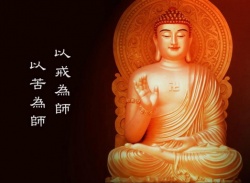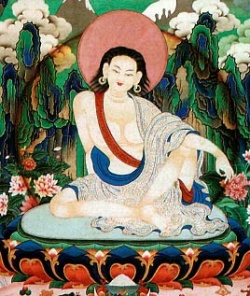Dasabalaa (2) Sutta
Ten Powers (excerpt)
translated from the Pali by
Maurice O'Connell Walshe
"It is not by that which is low,[1] monks, that the highest is attained; it is by the highest that the highest is attained. Most excellent[2] is the holy life. The teacher has come to you face to face. Therefore stir up energy, monks, to gain what has not been gained, to attain what has not been attained, to realize what has not been realized. Then this our leaving the world[3] will not prove a barren thing, but fruitful and productive of results. So too the requisites[4] we enjoy — robe, alms, lodging, medicine in sickness — trifling as they are, will be very fruitful for us, very profitable. For thus, monks, you must train yourselves: perceiving his own benefit[5] a man should exert himself tirelessly,[6] perceiving the benefit to others, he should exert himself tirelessly, perceiving the benefit to both, he should exert himself tirelessly."[7]
Notes
1. Hiina.m: This is the adjective used in the term "Hiinayaana," as contrasted with the designation "Mahaayaana," for the developed or expanded Buddhism of the Northern schools. Curiously enough, it is often adopted today by Oriental Theravaada Buddhists themselves, despite the fact that it is both offensive and erroneous. The facts are set out succinctly in E. J. Thomas, History of Buddhist Thought (London 1933), 177f. According to Thomas, yaana in this context means not "vehicle," as usually translated, but "career." Thus Mahaayaana designates the "great career" of the Bodhisattva (cf. SN 12.10, n. 2) as distinct from the "disciples career" (sraavaka-yaana; Pali saavaka-yaana) and the career culminating in the status of "solitary Buddha" (Pratyeka-Buddha; Pali Pacceka-Buddha), who is enlightened but does not teach. The word hiinayaana "low or base career" is "a term which has become popularized as the translation of a phrase used by Chinese pilgrims, who seem to have known it as a convenient name for all schools which were not Mahaayaana. But this is not the way the term is used in the Sanskrit texts" (Thomas). It is time the opprobrious term was dropped altogether, and especially with regard to Theravaada, a school almost certainly unknown to those who coined it. It mainly referred to the long-extinct Sarvaastivaadins (cf. n 65).
2. Ma.n.dapeyya.m: lit. "to be drunk like cream."
3. A rare case in which the Buddha associates himself with his disciples in order to encourage them. For him, his "leaving the world" has already produced the highest results.
4. The standard list of "requisites" permitted to a bhikkhu.
5. The benefit to himself (attaa). Here, as elsewhere, the Buddha does not hesitate to refer to "self" in the relative, conventional sense (cf. SN 3.8, n. 1).
6. Ala.m... appamaadena sampaadetu.m: cf. the Buddha's last words as given in the Mahaaparinibbaana Sutta (DN 16). The Rhys Davids translation there (DN 16, vi, 7 [ii, 156]) "Work out your salvation with diligence"; has become altogether too popular.
7. This provides one of the two main answers to ignorant suggestions that Buddhism is "selfish": (a) since, in terms of absolute truth (cf. SN 1.20, n. 8), all things are "self-less" (anattaa), there is no real basis for selfishness; and (b), as here, since in the relative sense according to which "selves" can be said to exist, the Dhamma is of benefit both to oneself and to others.

